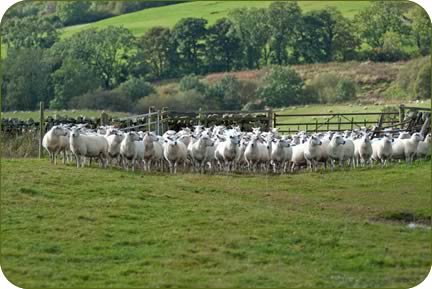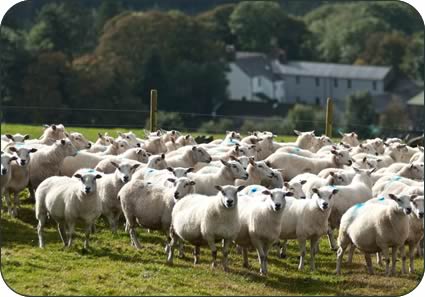Jennifer MacKenzie is an agricultural photo journalist with almost 30 year's experience. Operating from her base in Cumbria, Jennifer undertakes mainly industry-related freelance writing and photography.
Disease Control Uppermost
Colin Forsyth made some radical changes to the sheep enterprise when he
took on the family farm near Thornhill near Dumfries 11 years ago.
With flock health and the control of disease and ultimately production uppermost in his sights, he switched from the area’s traditional Scotch Blackface, which had produced Mules which were crossed with the Texel, to Lleyns, drawing from his experience of easy care sheep and farming without subsidies while working in New Zealand for a year after graduating from university.
“I wanted a closed flock because if the sheep are born on the farm and are adapted to the conditions they are bound to last and perform better,” said Colin.
 |
Vet Alistair Padkin, left, of Solway Vets’ member practice Nithsdale Vets, and Colin Forsyth regularly review the sheep health plan. |
“With the change in subsidies, I couldn’t afford to carry any passengers and with a closed flock I can select for problems and cull accordingly,” added Colin, who took on the running of the farm from his father, Sandy who is now a director of an agricultural consultancy business, Cara Consultants.
“My original plan was to produce replacements and then cross them with a terminal sire on the ground further down the glen. But I got on so well with the Lleyns that I didn’t want to compromise - it’s all about the number of lambs on the ground. The main aim is to get as many twins as possible and therefore increasing kgs of lamb sold from the farm “
Lameness was a concern for the new flock and a flock health plan was drawn up with vet Alistair Padkin of Nithsdale Vets, Thornhill. The plan is drawn up annually but it is a ‘work in progress’ as Colin regularly discusses the flock’s health with Alistair throughout the year.
“It’s important to have the time to discuss health issues with your vet.It’s vital to have a close relationship because sheep are always finding different ways to die! The lameness was such a problem I was considering changing my system again,” said Colin.
The lameness
was caused by digital dermatitis and footrot in the ewes so a specific
plan was drawn up to tackle the problems.
 |
| Colin Forsyth chose to run a closed flock of Lleyn ewes which would adapt to the conditions on the hill at Bennan. |
One of the biggest influences in reducing the lameness was being ruthless in culling the lame ewes which were isolated after the lambs were weaned. A programme of footbathing and injecting with antibiotic was also implemented, but this is now not necessary.
Each year 500 ewe lambs and 1,500 store lambs for finishing are wintered away on lowland grazing. The ewe lamb replacements were returning to the farm with digital dermatitis.
Now all the lambs are injected with Micotil before they are away-wintered and the lameness has been reduced to virtually nil.
The injection is also had other benefits, helping reduce pneumonia in the lambs which can be brought on by the stress of movement and the lush environment of the lowland pasture.
“We are not using any more antibiotics in the long term - previously we were using bottles of oxytetracycline. It’s unbelievable how well it works.
“It’s how to value my time which previously involved setting up a mobile handing unit and spending a day dealing with the lame lambs,” It was also affecting the performance and growth rates of the lambs, said Colin.
 |
| Lleyn Ewes |
Records have been kept for the last 11 years and the ewes scan at up to 160% with up to 145% marked. Colin believes that all farms have a sustainable level of production and he is relatively happy with the results from an extensive hill farm although constantly monitoring figures and benchmarking are vital he believes.
The ewes are run as two flocks with the first rams going out with 700 ewes on November 1 and remainder on November 22 with the first batch of lambs due in the last week of March. All the ewes are lambed outdoors.
As part of the flock health plan, the ewes are dosed for fluke three times a year, January June and pre-tupping. All sheep are also vaccinated against toxoplasmosis and enzootic abortion, with Toxo being a problem in the early Lleyn flock several years ago.
Tick-borne fever is also a potential problem in the area. Sheep grazing a particular part of the hill are susceptible and they are treated with pour-on before being turned out.
Only the lean and scouring ewes are wormed pre-tupping and then all ewes are given Cydectin a few days before lambing when they are brought down from the hill at around 1,000ft to the lambing fields.
Lambs get a white drench at marking time and all lambs receive a Zolvix drench in late summer. Clik pour-on is also used and gives 100% success in preventing blowfly strike. Lamb losses from scanning to marking are 10 to 15%.
Lambs are weaned in the second week of August. Not all lambs are finished away with up to 500 lambs either finished off the farm or sold for breeding.
The Stabiliser herd has been established for 10 years and achieves upto 98% calving rate and cows easily calved without assistance. Breeding heifers are sold as well as stores to be finished through the Morrisons Traditional Beef Scheme.
Nithsdale Vets, based at Thornhll, in Dumfriesshire, has long practised a proactive approach to flock and herd health with its 200 large animal clients, reflecting an ethos projected by regional veterinary association Solway Vets, formed in summer 2011 to promote best practice and pool expertise and services among its seven practices involving more than 50 vets.
The farm:
Bennan and Markmony, Tynron, Thornhill
Farmer Colin Forsyth
2,000 Lleyn ewes all bred pure
85 cow Stabiliser herd put to the Stabiliser bull
1,500 LFA acres acres rising to 1,300ft above sea level

